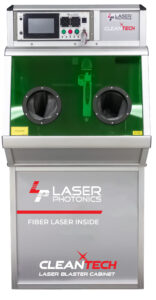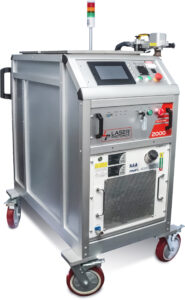Clean Tech Lasers Promote Superior Welds
Laser systems remove residue, corrosion, and existing coatings from metal weld surfaces quickly, with less preparation and mess than traditional techniques.
Posted: April 15, 2023

High quality welding begins with cleaning the base metal of any corrosion, contaminants, or existing coatings that could compromise weld penetration and integrity. Ensuring the metal is properly cleaned from the start makes the job easier and eliminates the need to start over to achieve a clean weld.
Unfortunately, the traditional techniques used for this purpose – such as sandblasting, chemical stripping, and grinding – are messy and require expensive consumables, as well as substantial time for preparation and cleanup. These methods are also drawing scrutiny from regulators like the EPA and OSHA since they can pose risks to the environment and applicators.
Today, a more effective alternative is utilizing industrial-grade, precision laser-based systems that can remove contaminants, rust, residues, and paint from the weld surface with a high-energy laser beam that leaves the substrate unaffected. Preparation and cleanup time are minimal, and the low-maintenance equipment can last decades.
According to Vincent Galiardi, owner of Galiardi Laser Clean, a surface cleaning operator based in St. Charles County, Missouri, many people are surprised to learn that clean technology lasers are the most cost-effective, efficient, and safest method of industrial surface preparation.
“Many people are unfamiliar with the use of lasers to treat metal surfaces,” says Galiardi. “When I do a demonstration, at first the people in attendance are skeptical. But after I use the laser to treat a small area, everyone starts talking and getting excited. By the end, when I let them try the equipment, everyone is having a good time and saying how great the laser works.”
For welding applications, Galiardi says, “Pre-weld, laser technology can effectively clean the surface so there is no contamination [to interfere with the weld.] Post-weld, lasers can remove discoloration due to oxidation, which can help to improve stainless steel welds.”
Given its effectiveness treating metal surfaces, industrial laser systems are increasingly being used in welding applications. Technicians can use mobile handheld units, or the systems can be integrated into automated inline processing lines. With significant advantages in safety and efficiency, laser cleaning is poised to disrupt the welding surface treatment market.
Resolving Conventional Cleaning Challenges
Pre-weld, any impurities on the surface of the base material such as grime, residue, corrosion, mill scale, or old coatings will compromise the weld’s effectiveness. Any contaminants can interfere with the process, cause resistance, or result in a weld splash when small metal particles become airborne or remain loosely attached to the welding area. Contamination on a weld’s surface leads to porosity, or bubbles of trapped gas in a finished weld that can weaken its mechanical properties and requires rework.
Post-weld cleaning is also necessary, particularly for stainless steel. Stainless steel offers natural corrosion protection through an ability to “passivize” itself if the environment provides enough oxygen to repair a surface film comprised of chromium oxide. However, welding can cause a “heat tint” – a discolored, thickened top layer on the stainless steel around the weld bead within the heat affected zone – that compromises the corrosion resistance. Removing the heat tinted top layer is necessary to restore the full corrosion resistance as well as aesthetic value of stainless steel.
To treat weld surfaces, sandblasting, chemical stripping, or grinding are traditionally used as industrial cleaning processes. However, these options have limitations.

Sand Blasting
Abrasive sandblasting involves forcefully projecting a stream of abrasive particles onto a surface, usually with compressed air or steam. The silica sand used in abrasive blasting typically fractures into fine particles and becomes airborne, which can cause serious or fatal respiratory disease.
“When sand or any other media is used to knock off particles from a substrate, there is always a byproduct that has the potential to become airborne and inhaled,” says Galiardi. “Besides the sand, this could be the particles you’re removing – the coatings, plating, anodizing, corrosion, and even lead paint.”
Sandblasting also is time-consuming to clean up since the sand essentially scatters everywhere, even though it is usually considered a “fast” cleaning method.
Chemical Stripping
With chemical stripping, harsh, even toxic chemicals or pastes are used to strip welds and metal-based objects of contaminants, rust, and paint to bare metal. However, for operators, exposure to corrosive acids and noxious chemical fumes is inherently dangerous. The process can also be time-consuming to prepare, achieve the required level of cleaning, and dispose of the waste. In addition, disposing of toxic chemicals is costly and closely regulated by agencies like OSHA and the EPA.
Grinding and Sanding
An angle grinder can remove large contaminants, and a sanding disc can remove rust, paint, and mill scale. However, the aggressive nature of the grinding can quickly ruin the metal to be welded if great care is not taken.
“Disc grinders basically just chip off [the rust] and it becomes airborne and makes a mess. Grinders can also be dangerous because sparks or debris can shoot off the wheel or catch an article of clothing,” says Galiardi.
Safe, Effective Laser Cleaning
Laser-based systems have significant advantages over these traditional methods, including ease of use in which an operator simply points and clicks a high-energy laser beam at the surface. The substrate is not affected by the laser, and the systems do not create any mess or byproducts. The approach is eco-friendly, energy-efficient, and completes the job in half the time of traditional methods when preparation and cleanup are considered.
“In our experience, laser cleaning is as fast at removing rust or old coatings as other methods, but without the same amount of cleanup,” said Galiardi. “When we treat a surface with lasers, any fumes or dislodged particulate is extracted into a HEPA filter and the job is done. There is no media [sand, chemicals] to replenish or clean up.”
Galiardi Laser Clean uses laser systems made by Orlando, Florida-based Laser Photonics, a leading provider of patented industrial grade CleanTech® laser systems for cleaning and surface conditioning. The American-made systems function either as mobile standalone units or can be integrated into production lines.

The laser systems are available in portable and stationary models ranging from 50 to 3,000-watts (a 4,000-watt version is in development) with chamber sizes from 3’ x 3’ in size to 6’ x 12’. The systems can also be installed in manufacturing lines in cabinets or operated by a robotic arm.
Galiardi says that laser treatment of metal surfaces can be used to streamline weld cleaning processes even in relatively remote areas in the field.
He relates how he used a portable CleanTech laser system for a welding project for the iconic skywalk at the Grand Canyon. The skywalk extends over the rim of the Grand Canyon and provides a clear view thousands of feet to the canyon floor below.
“When I did the skywalk job at the Grand Canyon, I removed paint [from the skywalk welds] with the laser system to allow non-destructive testing of the welds [before repainting]. The system’s portability made it quick and easy to use in the field without the cleanup or safety issues of conventional cleaning processes,” says Galiardi.
With clean laser technology, there is now an environmentally friendly alternative to abrasive blasting, chemical stripping, and grinding for pre and post weld surface cleaning. The approach is safer for operators and highly adaptable to a wide range of welding applications.
“As people become more aware of laser-based systems and compare them to traditional methods, they need to factor in prep and cleanup time, which can significantly impact project cost. When the improved operator safety, equipment longevity, and lower maintenance of laser systems are also considered, the clean laser technology has a much higher ROI,” says Galiardi.
The longevity of low-maintenance laser systems further adds to their value, increasing ROI, and making replacement unnecessary for decades.
“CleanTech laser systems can last for 50,000 to 100,000 hours. That’s many decades working eight-hour days. After purchase, there’s virtually no maintenance necessary,” concludes Galiardi.
Subscribe to learn the latest in manufacturing.








